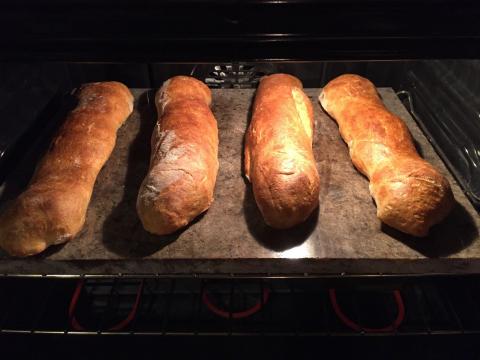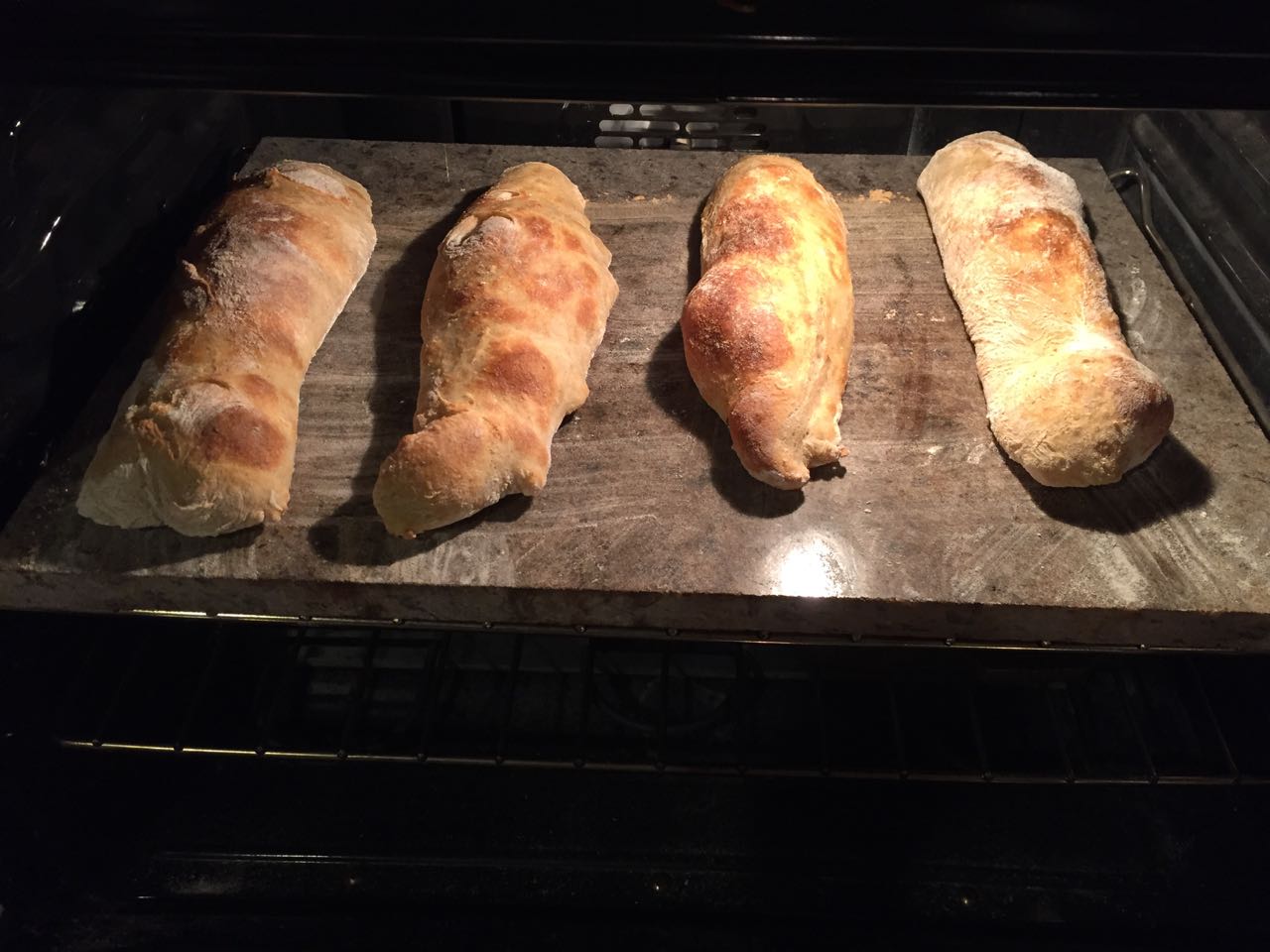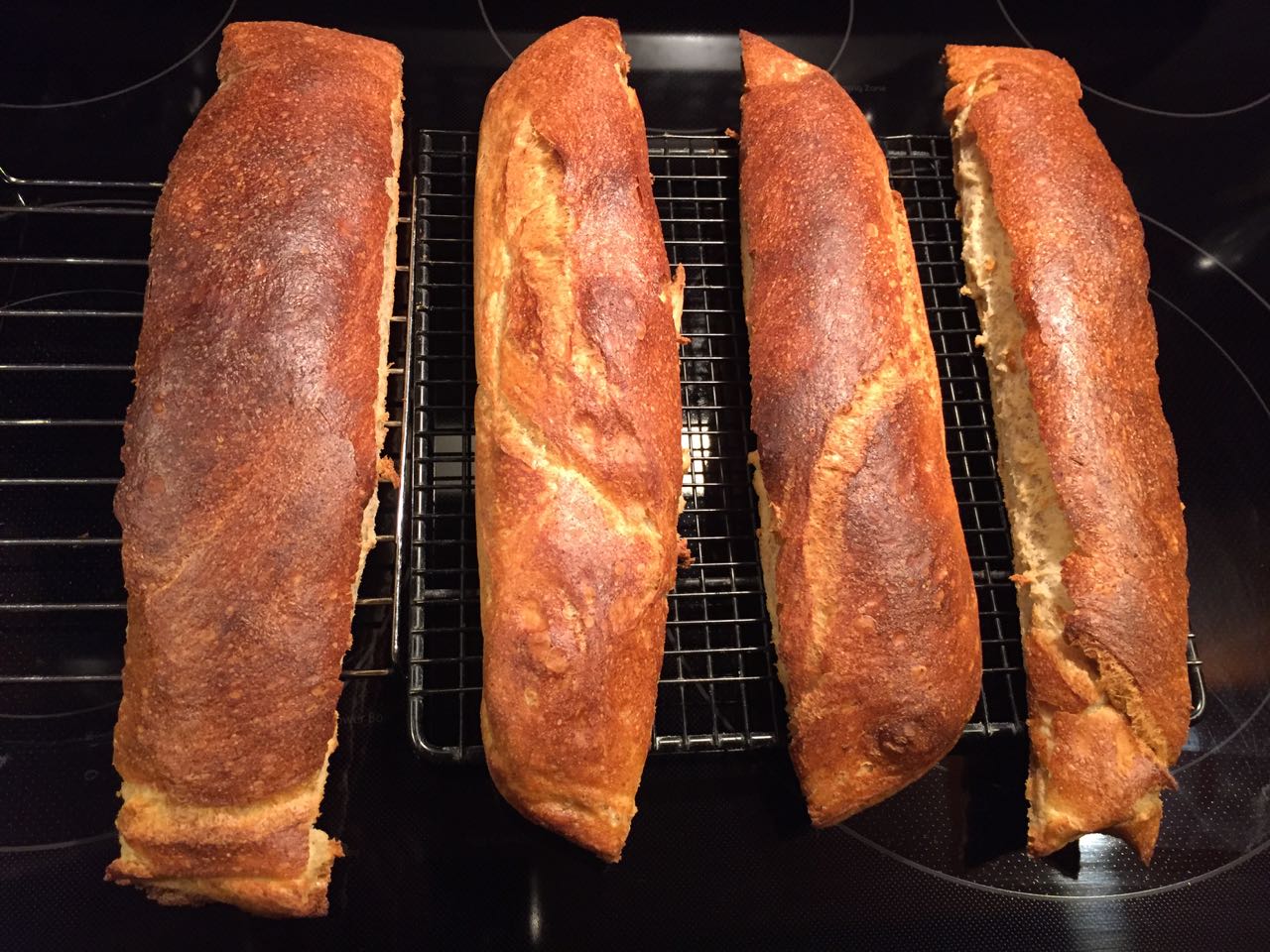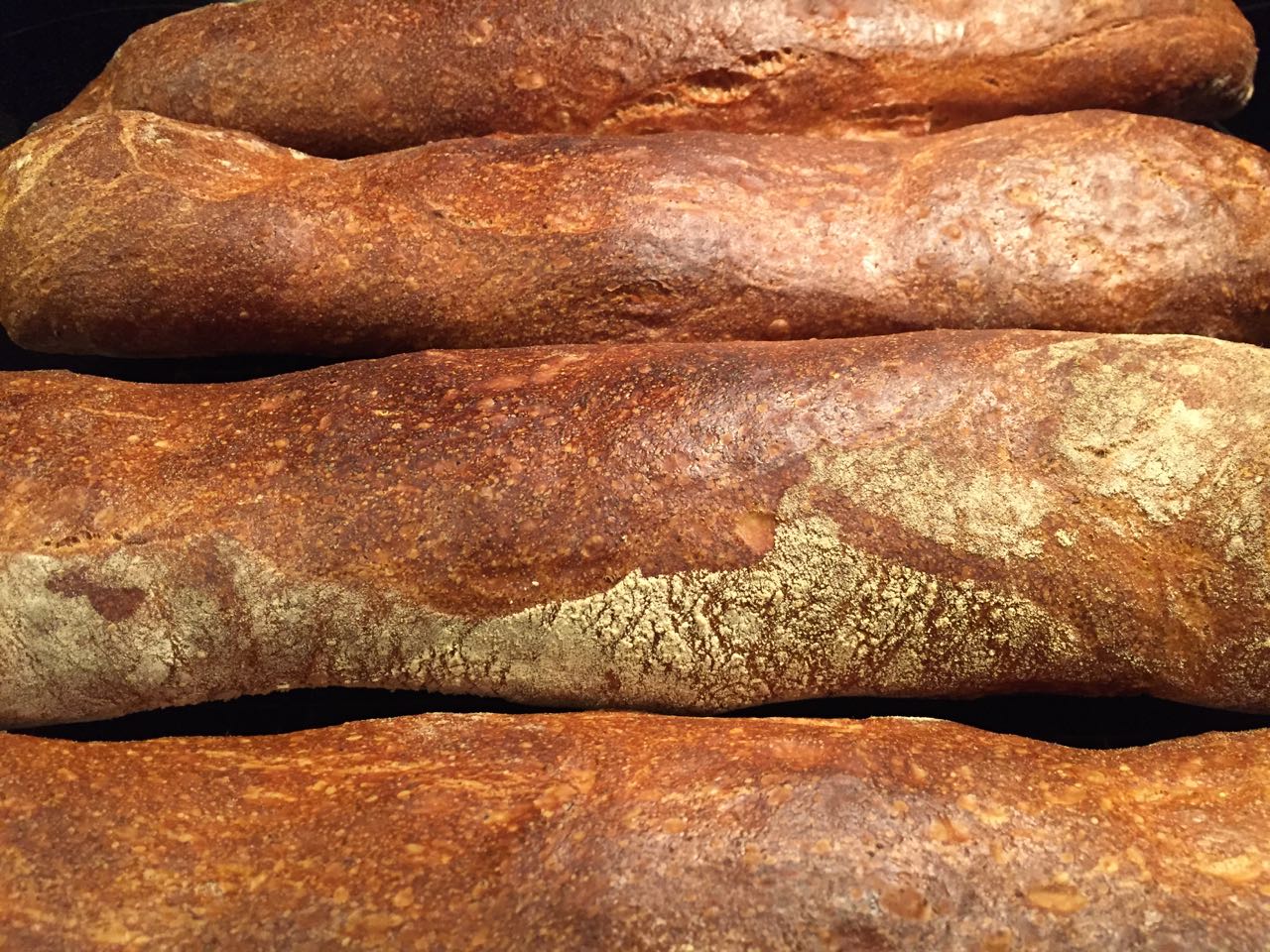
Pan de Cristal - cracking the code

Pa de Vidre / Glass Bread
I’d made this once before a few months ago after warehousing Abel’s posting for over a year. Time to try again and figure out the mysteries & miseries of how to make this bread “properly". And it took about 4-5 iterations over the course of a week, each time trying a new thing or two. Until I had a breakthrough two nights ago in the mixing phase on my final failed attempt. But with some additional tweaking, last night’s product came out of the oven looking pretty darned close to what I was after.
There were two key elements to the success. The first was to the initial mix being performed by hand rather than relying solely on my mechanical mixer. This step now develops a smooth fully incorporated dough ready for the mixer. The second was the careful handling of the dough during the transfer from bench to oven peel. the “wettest” and lightest handling of the divided dough as possible.
Pan de Cristal is a fairly amorphous animal that dares the baker to move it from bench top to oven peel without partially or totally destroying the anticipated shaping or the structure of the dough. At a total of 95% hydration (90% water, 5% oil) with 90% white flour, it is not one to accommodate any type of man-handling. So I knew and so I’ve learned.
My first attempts last week varied the hydration from 95% - 85% in failed effort to get the dough to behave. But the hydration isn’t really the issue. It’s like having musical notes on a page - which account for only 10% of what the final sound is - the other 90% is the skill and soul of the musician.
When I decided to forego the dividing and shaping altogether by placing the entire BF'ed mass into a baking dish, the notes didn’t play so well. But at the point I had already unlocked the “secret” to getting a well mixed and well developed dough.
This dough rises very fast due to the IDY, Levain and sugar. In my kitchen, 90 minutes was about all it took to triple in size. The addition of Letter Folds at 0, 30 and 60 minutes provides the strength this dough needs to be workable at all - at least to me.
| Pan de Cristal, Levain Formula | |||||||||
| Abel Sierra, alfanso | |||||||||
| Total Flour | |||||||||
| Total Dough Weight (g) | 1250 | Prefermented | 20.00% | ||||||
| Total Formula | Levain | Final Dough | |||||||
| Ingredients | % | Grams | % | Grams | Ingredients | Grams | |||
| Total Flour | 100.00% | 624.0 | 100.00% | 124.8 | Final Flour | 499.2 | |||
| Bread Flour | 90.00% | 561.6 | 100% | 124.8 | Bread Flour | 436.8 | |||
| Rye | 10.00% | 62.4 | 0% | Rye | 62.4 | ||||
| Water @40dF | 90.00% | 561.6 | 100% | 124.8 | Water | 305.7 | |||
| bassinage | 131.0 | ||||||||
| Salt | 2.00% | 12.5 | Salt | 12.5 | |||||
| Olive Oil | 5.00% | 31.2 | Olive Oil | 31.2 | |||||
| Sugar | 2.00% | 12.5 | Sugar | 12.5 | |||||
| IDY | 1.33% | 8.3 | 0.00% | 0.00 | IDY | 8.3 | |||
| Levain, chilled | 249.6 | ||||||||
| Totals | 200.33% | 1250 | 200.00% | 249.59 | 1250 | ||||
| Alternate mixer speed slow and fast while incorporating all ingredients. | |||||||||
| Add Flours,intial Water, cold Levain, IDY. Hand mix well. Autolyse 20 min.. | |||||||||
| Hand mix/add Salt, Sugar to incorporate. Dough is wet enough take it well. | |||||||||
| 50 French Folds. 5 min rest. 50 French Folds. | |||||||||
| Into mixing Bowl. Slowly add Bassinage alternating hand and machine mixing. | |||||||||
| Once dough starts to form ridges in the mixing bowl, slowly add Oil and finish mix @78d | |||||||||
| Mix is done when dough slaps against sides of mixing bowl and hook alternately picks up and drops dough back. | |||||||||
| Dough into oiled tub, immediatly fold well. Allow to triple in height. In my warm kitchen tthis was ~1hr 40 min. | |||||||||
| Spill onto well floured workbench. Will likely be goopy. | |||||||||
| With wet hands and wet bench knife (at all phases) square off edges and divide as desired. | |||||||||
| Pick up and place onto parchment paper on peel. Try to not compress, squeeze or stretch the dough in the transfer. | |||||||||
| Oven should have been preheating at 480dF. | |||||||||
| Bake at 460 ~13 min. w/steam. | |||||||||
| Release steam rotate loaves, continue baking at 440dF for up to 30 min. Oven off, vent for 3 min. | |||||||||
An earlier failed attempt at 85% hydration. The crumb was okay, actually fairly good.

This was the 95% hydr. failed baking pan attempt. At this point two nights ago I'd figured out how to get a quality mix and Bulk Ferment.

And the resultant batons. Just did not work - at all! Dense and overly chewy. At least the crust was in the vicinity of where i wanted to be.

The lead photo and these next few were last night's success story. I don't think the look of the bread is all that off from what I imagine it should be.




The bread is incredibly light and airy and when freshly baked or reheated/toasted the crust takes on that snap which likely gives the bread its name, while the crumb remains moist and tender. I am not often a fan of the "rustic" look of bread that has more than a minimum of raw flour on the crust. And so I appreciate that these do not.


Comments
The crumb is beautiful, Alan. How would you describe the chew and taste?
How do you think eliminating the commercial yeast would affect the bread? Pros and cons.
Danny
There's a significant amount of IDY in this formula, which certainly enhances the BF timeframe. I'll venture a guess that the BF would be significantly longer without it, not much guess work there. As there is no retard time after shaping, rather goes directly into the oven, the IDY may also enhance the oven spring somewhat. Beyond that, I'm lost as to what would happen.
i think that this bread is supposed to not get explosive oven spring anyway, the two main features are the very thin hard crust and the open crumb while being much lighter, weight wise, than most other breads.
the crumb itself is not chewy at all, and my wife described the taste of an earlier iteration as reminding her of popcorn! To me, the taste is just clean and refreshing. I think this would make for a fantastic hamburger bun with the crust serving as both the top and bottom, as it is with ciabatta. And it makes for a fantastic toast.
Dup
Dup
Alan, you are a master of obtaining a nice crumb in a baguette (mine resemble the real thing from the outside, but the crumb remains dense). How would you compare the challenge of producing a nice crumb from this recipe with the challenge of a standard baguette? Is it mostly in the handling? Or does the mixing also make a difference?
Thanks for posting.
Ted
kendalm, no longer active on TFL, had superb crumb, as did and do a host of others. So when it comes to baking a true French Baguette traditional those folks regularly exhibited some truly extraordinary crumb skills.
The distinction that I guess I bring to the table is that I am pretty much willing to try and bake anything, any formula, as a baguette. Well, not just anything, because it has to appeal to me in the first place. That, to me, is where the real fun lies. And I just don't see too many others do that. So there's that (not so) secret pleasure in finding that I'm breaking 'new' ground.
I really admire Abel's postings and find trying my hand out on some to be my cup of tea. Like this one, also particularly because I was fortunate enough to find myself in Barcelona last year, where this bread has its 'roots', and to have met a good friend of Abel's.
now on to address the heart of your question. This dough is so much more like a Ciabatta than anything else, but even more so in that the hydration is pumped up many percent higher. Therefore, in the same sense that Ciabatta must be handled differently than 'conventional' dough, it has to be handled at the next step of ultra care. A pair of kid gloves inside of kid gloves might reinforce the care it took me to not screw this up. Of course I'd like to eventually get the breads to be even more uniform in shape, so there's more work to be done.
it isn't handled anything like a standard Baguette dough. If you haven't played around with Ciabatta much it would be good to take a couple of views of the work of Ciril Hitz at ~minute 9:25 https://youtu.be/LFja1ShZFsA . The pan de cristal is a much looser and wetter blob though and once handled and moved to the oven peel on parchment, if disturbed, I found it near impossible to manipulate further. And even just getting it moved to the oven peel required some nerves of steel. Hence the double kid gloves reference.
as far as mixing, I found that the initial mix, pre bassinage and addition of olive oil, was best accomplished by hand using my standard mixing techniques. I was able to get a smooth and consistent dough this way. Prior, in my old Kitchen Aid mixer with the old style dough hook, the dough would be somewhat lumpy and the mixing much more work. With this 'new' way the second stage mechanical mixing was lessened by quite a bit of time and the dough came together more rapidly and consistently.
I hope this addressed your questions.
alan
Alan, you covered a lot of ground. Thanks for all of the info. One irony is that I have no problem producing open crumb ciabatta. That dough does not present too many problems, including going from the couche to the peel (although I know now to avoid any sagging in the middle of the dough as the transfer is made -- the stretching cannot be remedied in any way at all). Do you use a handling board for baguettes? Or instead transfer the dough entirely by hand?
By the way, I am with you on the "rustic look" comment and always use a pastry brush to remove any loose flour as soon as the loaves come out of the oven.
Happy baking.
Ted
here it is in action...
https://youtu.be/TGF3ApIXn6U
a piece of engineered wood flooring bought at Home Depot and cut down. Fancy, no?